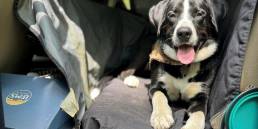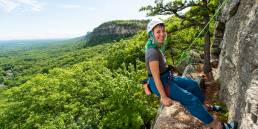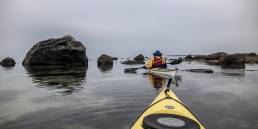As I struggled to the top of a gentle, rolling hill on Mineral Bottom Road, I was sure we had made it. It’s only 12 miles of riding from the top of the canyon to the parking area and surely we’d put that mileage behind us by now. But when I reached the crest and saw the dusty path winding for miles and miles into the distance, out of sight, I broke down and cried. With my head in my hands, straddling my bike, I sobbed uncontrollably, ready to be done.

I’ve made a practice of writing about my family’s bike trips shortly after we return home from each adventure. The events are fresh in my memory, so as I look over my hastily-written notes, scribbled on the margins of the crumbled itineraries and maps I carried, I can generally fill in the gaps as I write. When in doubt, I ask my sons and husband for help. Which day did we get caught in that downpour? What was the name of the restaurant with the great French fries? When did we encounter that huge hill? Not the one where we had to repair the chain, the other one. I can count on them to remember.
But some adventures require more time to sit with. Our self-supported, three-day cycling trip on the 100-mile White Rim Trail in Canyonlands National Park was one of those adventures. With no water sources, no cell service, no amenities (with the welcomed exception of conveniently spaced toilets), this trip was our biggest adventure yet. It also required the most amount of planning.
All trips require quite a bit of research. This one had several significant logistical issues to tackle. It was our first adventure that would require plane tickets, so we would have to either fly with our bikes or rent bikes. It would require highly-coveted backcountry permits which were not easy to obtain. Most importantly, though, it would require us to carry all of our water. Ultimately, the amount of water we could carry would dictate the number of days we could ride.

After a lot of consideration, I landed on 40 liters for the four of us over three days—about three and a third liters per person per day. This ended up being an adequate amount. It also rained the night before our ride and we were able to refill at the end of our first day by filtering water from puddles on the smooth rocks. (Though this obviously won’t work for everyone, though.)
Next, I set about finding two campsites spaced fairly equally apart. I studied the map, determined we’d ride clockwise, called the Ranger station to ask questions about the sites, made the Canyonlands Backcountry Reservations website the homepage in my browser, and for two dyas in a row in mid-December, set my alarm for 1:50 a.m. so that I could be on the website at midnight MST to reserve Gooseberry A and Potato A. (Much to our surprise, despite the fact that these reservations go so quickly, we camped alone both nights, with no one in sight.)
The last big piece of the puzzle was the bikes. After a detailed price comparison of renting bikes versus shipping or flying with our own we decided to rent bikes and bikepacking bags in Moab. They set us up with four Cannondale Cujos that were perfect for the terrain and they worked with us to determine the bag set up that we needed for water and gear.

Over the next four months we worked to lighten our load. We upgraded two of our sleeping bags, all four sleeping pads, and invested in one new tent. This was the first time we would use a bikepacking system, as opposed to a bike touring system. Bikepacking bags force you to become more efficient with your packing strategy. Panniers (for bike touring), allow for more room, and you inevitably pack more than you need. We slashed items from our packing list and got it down to the bare bones. In the end, we were able to pack everything we needed in our carry-on bags.
Finally, after months of planning, April vacation arrived. We flew into Salt Lake City and drove four hours to Moab. The next morning, we found our bikes ready and waiting for us. We dropped our bags on the floor of the shop and proceeded to dump all the contents out to begin the process of determining what fit best where. We quickly realized that our sleeping bags needed to come out of their sacks in order to be stuffed into the bags.
After packing our bikes and taking a quick ride in the parking lot to make sure they were adjusted properly, we loaded them into the truck and set off for Canyonlands, where we intended to camp the night before our ride.
It was cool and drizzly in Moab and as we climbed up into Canyonlands I saw a dusting of fresh snow on the hills. At first I pretended not to notice but soon it was impossible to ignore and by the time we reached the Welcome to Canyonlands sign we were in a blizzard. April is a tricky time of year to plan a bike trip.

The next morning, we drove back up to Canyonlands to see what the day would offer. To our relief, the snow had disappeared, the ground was mostly solid (just a little mud), and the temperature was headed towards 60 degrees. This would do just fine. We parked at the Shafter Overlook, took in the remarkable view, unloaded our bikes, checked and re-checked our gear, and headed off, carrying all the food and water and emergency gear that we would need for three days. The multi-colored landscape was an appropriately dramatic backdrop.
A few hours into our journey we came across a group of cyclists taking a break. We joined them and started chatting and they asked where our support vehicle was. When we told them we were self-supported they were aghast. They questioned us a bit about our gear and qualifications and were obviously dubious about our choice to bring our family into the desert without a support vehicle, but they were polite enough. After a while we bid them goodbye and headed off. As I started to ride away one of them yelled back to me. “Ah! I see you have Duct Tape! Smart woman!” Somehow a roll of Duct Tape strapped to the back of my pack gave me creditability. I get it. You’d have to be a fool to go on a trip without it. (We used it to repair our water bottles, twice.)
The details of our journey blur into a swirl of stunning switchbacks, colorful cliffs, sharp turns and steep drops, hard-earned miles, and above all, miraculous beauty. From the first rays of sunlight illuminating the mesas, to the last shimmering beams casting a warm glow over the canyon, to the stunning display of stars at night, traveling by bike in the desert is surreal and spectacular and scary. As we crawled into our tents at night, alone in the inconceivably open space, I felt utterly vulnerable and thoroughly peaceful. Those were undoubtedly connected.

On our last day the climb out of the canyon was rough. Our sons biked up but my husband and I pushed our bikes. The tremendous physical excursion it required, combined with the sadness of leaving such a remarkable place, and the overwhelming relief that we’d made it to safety, all left me sobbing like a small child on the side of the road. My younger son said he thought he could see the main road up ahead (a blatant lie). My older son offered me a Snickers bar (I accepted). After some more crying, I was ready to push on. It’s not the first time I’ve been reduced to tears on a fun family vacation. Big adventures can be tough. This one taught me the true length of a desert mile and left me (after some time and distance) wanting more.
Sarah Hunter
Sarah is the communications director for Pine Island Camp, a trip leader for the Appalachian Mountain Club, and a freelance writer. She lives in Maine with her husband and their two sons, and together have trekked and pedaled thousands of miles – from day hikes and backpacking trips in the high peaks of New England to week-long, self-supported bike tours in the US and Canada.
Related Posts
April 24, 2024
What to Bring When Road Tripping with Your Dog
Prepare for the ultimate road trip with…




